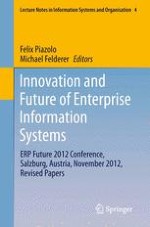This volume presents the revised and peer reviewed contributions of the "ERP Future 2012" conference held in Salzburg/Austria on November 11th - 12th, 2012.
The conference is a platform for research in ERP systems and closely related topics like business processes, business intelligence, and enterprise information systems in general. To master the challenges of ERP comprehensively, the ERP Future 2012 Research conference accepted contributions both with a business focus as well as with an IT focus to consider enterprise resource planning from various viewpoints. This combination of business and IT aspects is a unique characteristic of the conference and of this volume that resulted in valuable contributions with high practical impact.
